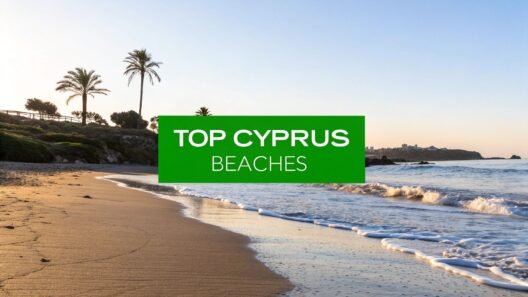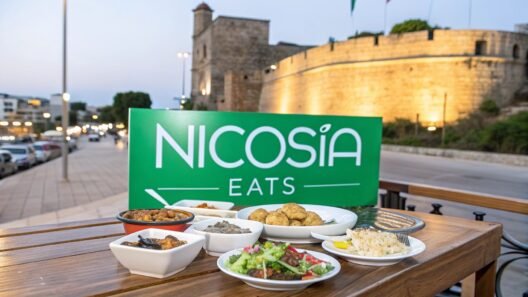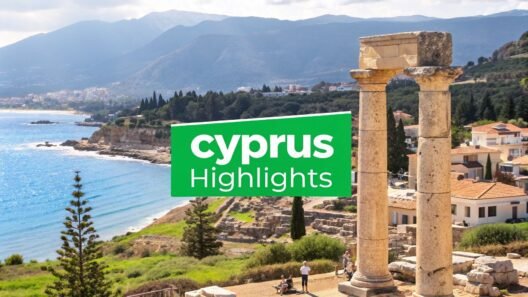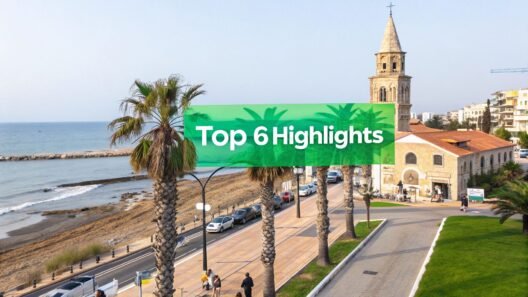Cyprus is an island of myth and legend, where ancient history whispers on the Mediterranean breeze and sun-drenched coastlines give way to cool, pine-scented mountains. While famous for its glorious beaches, the true magic of Aphrodite's Isle lies in its rich tapestry of culture, nature, and history. From Neolithic settlements to Venetian fortresses and Byzantine monasteries, the island offers a journey through millennia. This guide is your curated passport to the very best attractions in Cyprus, designed to help you craft an unforgettable itinerary.
We move beyond the typical tourist trails to provide insider tips and practical advice, ensuring you experience the authentic heart of this captivating destination. Whether you are exploring the rock-cut necropolis of the Tombs of the Kings, hiking the cedar-scented trails of the Troodos Mountains, or discovering the vibrant energy of Limassol's Old Town, this list covers the essentials. We have organised a definitive collection of must-see locations, from the legendary Aphrodite's Rock to the unspoilt wilderness of the Akamas Peninsula. Prepare to discover a Cyprus that is as diverse as it is beautiful, with experiences that cater to every type of traveller.
1. Tombs of the Kings, Paphos
Step back in time at the Tombs of the Kings, a sprawling necropolis and one of the most significant attractions in Cyprus. This UNESCO World Heritage site, located just north of Paphos harbour, offers a remarkable window into the island's Hellenistic and Roman periods. Despite its regal name, the site was the final resting place for high-ranking officials and wealthy Paphian aristocrats, not royalty.
The tombs, which date back to the 4th century BC, are carved directly out of solid rock. Many feature intricate Doric columns, frescoed walls, and impressive peristyle atriums, mirroring the grand houses of the living. Exploring these subterranean chambers feels like discovering a lost city, offering a profound sense of scale and architectural ingenuity.
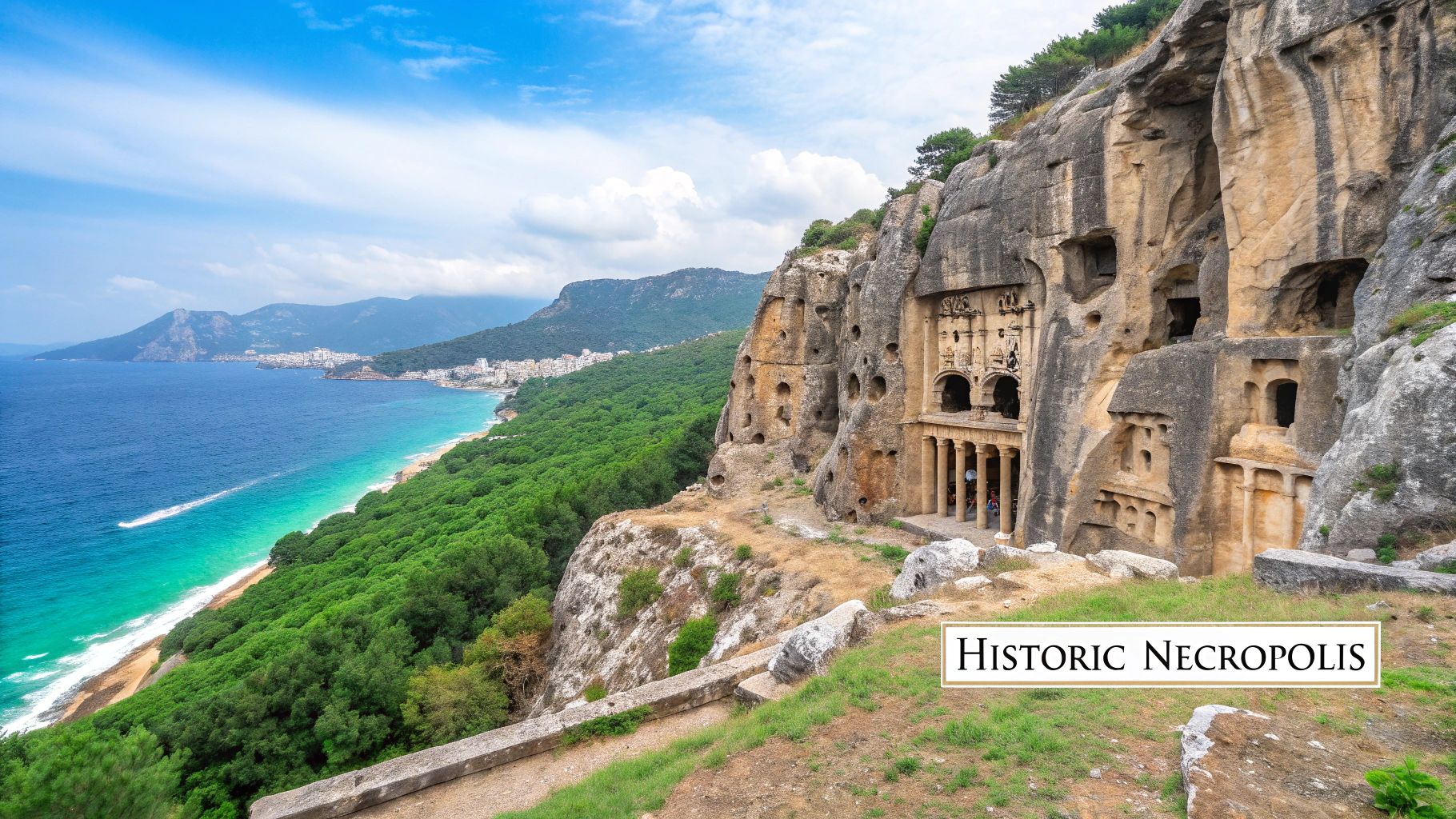
Visitor Information and Practical Tips
To make the most of your visit, plan ahead with these actionable tips:
- Best Time to Visit: Arrive early in the morning (just after opening) or late in the afternoon to avoid the midday sun and the largest tour groups. The golden hour light also provides a stunning backdrop for photography.
- What to Bring: Wear sturdy, comfortable walking shoes as the terrain is uneven and rocky. Sun cream, a hat, and plenty of water are essential, especially during the summer months. A small torch or your phone's light is useful for peering into the darker corners of the tombs.
- Combine Your Trip: The Tombs of the Kings is located close to the Kato Paphos Archaeological Park. Consider purchasing a multi-site ticket to explore both historical treasures on the same day for a comprehensive look into ancient Paphos. Allow at least two hours to explore the necropolis thoroughly.
2. Kyrenia Castle and Harbour
Discover the jewel of Northern Cyprus at Kyrenia Castle and its enchanting old harbour. This formidable 16th-century Venetian fortress stands guard over a picturesque, horseshoe-shaped waterfront, creating one of the most iconic views on the island. The castle's history is layered, with Byzantine, Lusignan, and Venetian influences evident in its architecture, offering a fascinating journey through time within its impressive stone walls.
Inside the castle, you'll find the Shipwreck Museum, a must-see attraction in Cyprus. It houses the remarkably preserved remains of a Greek merchant ship that sank off the coast around 300 BC, making it one of the oldest recovered shipwrecks in the world. The adjacent harbour, lined with converted carob warehouses now serving as charming cafes and restaurants, provides a perfect setting to relax against a backdrop of the Beşparmak (Five Finger) Mountains.
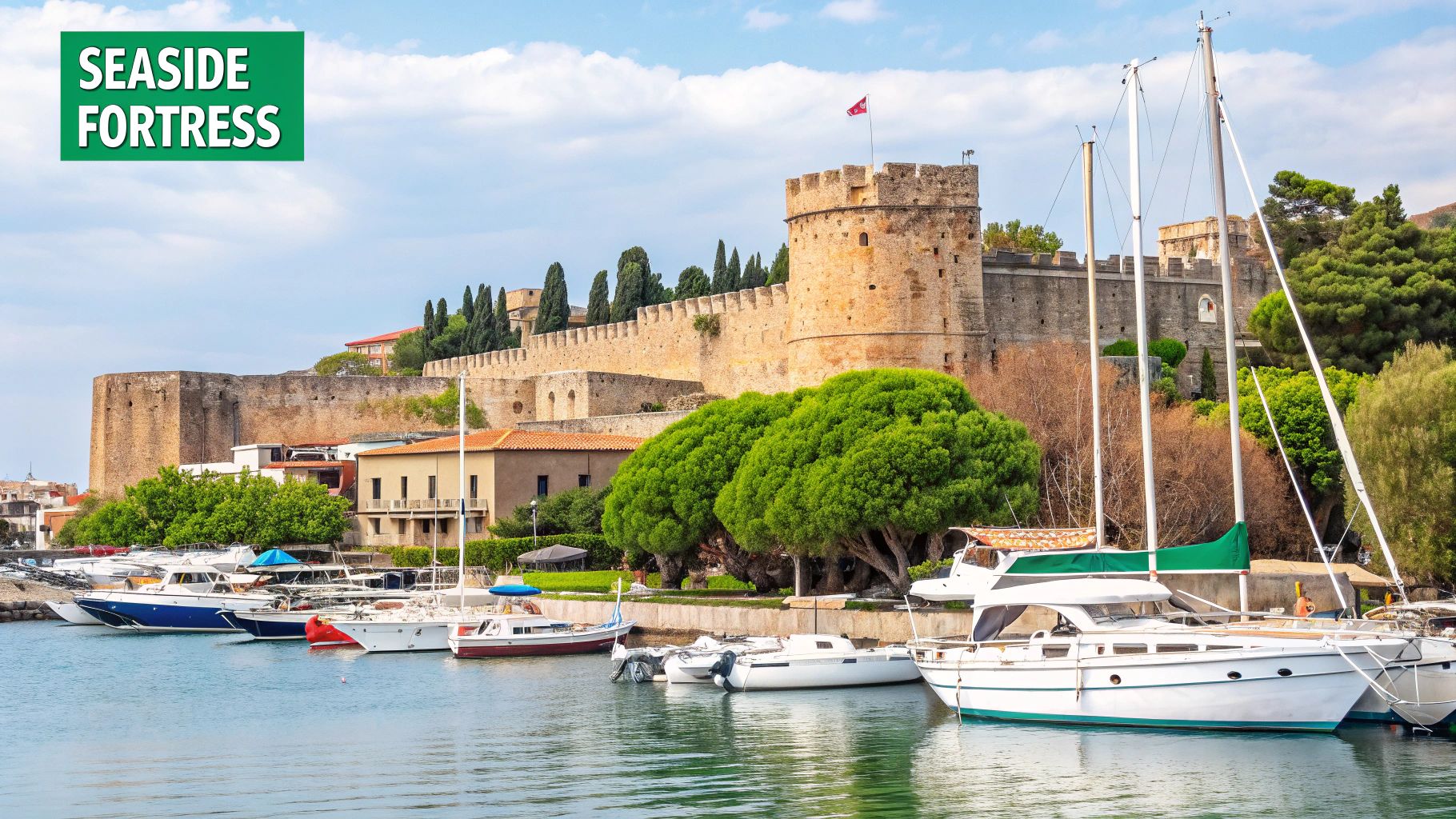
Visitor Information and Practical Tips
Plan your trip to this historic northern port with these essential tips:
- Best Time to Visit: Explore the castle in the morning to avoid the heat, then enjoy a leisurely lunch at one of the harbour-front restaurants. The late afternoon and sunset offer spectacular photo opportunities as the light casts a golden glow over the harbour.
- What to Bring: If you are travelling from the Republic of Cyprus, remember to bring your passport or EU ID card for the border crossing. Comfortable shoes are a must for walking along the castle ramparts and cobblestone streets.
- Combine Your Trip: Dedicate at least two to three hours to fully explore the castle and the Shipwreck Museum. To guarantee a prime spot for dinner, especially during the busy summer months, it is wise to book a table at a harbour-side restaurant in advance.
3. Troodos Mountains and Villages
Escape the coastal heat and discover the green heart of Cyprus in the Troodos Mountains, the island's largest mountain range. This region offers a breathtaking contrast to the sun-drenched beaches, featuring traditional stone-built villages, ancient Byzantine monasteries, and fragrant pine forests. It's a key destination for understanding the island's culture and one of the most diverse attractions in Cyprus.
The area is a year-round destination, offering cool hiking trails in the summer, like the popular path to the Caledonia Falls, and even a ski resort on the slopes of Mount Olympus in winter. Villages such as Omodos are renowned for their winemaking traditions, while the magnificent Kykkos Monastery showcases incredible religious art and history, making the mountains a rich and rewarding place to explore.
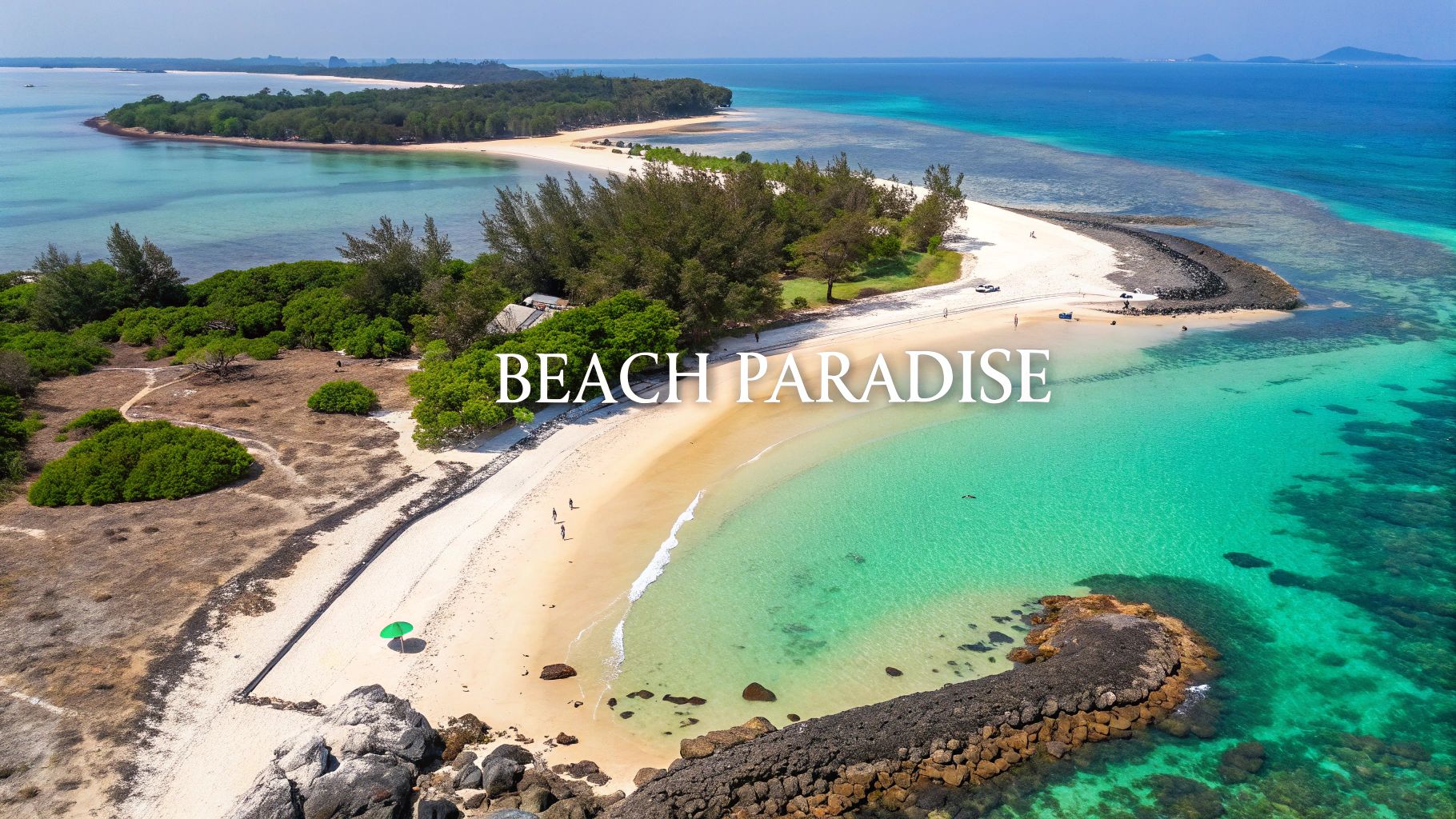
Visitor Information and Practical Tips
To fully experience the charm of this mountainous region, consider these practical tips:
- Best Base Location: Stay in villages like Platres or Kakopetria for central access to the main sights, hiking trails, and monasteries. This allows you to explore different areas without long daily drives.
- What to Bring: Pack layers of clothing, as the temperature can be significantly cooler than on the coast, even in summer. Sturdy footwear is a must for exploring villages and trails. Also, download offline maps before you go, as mobile signal can be unreliable in remote areas.
- Combine Your Trip: Plan a route that includes a visit to the famous Kykkos Monastery, a wine tasting in Omodos, and a scenic hike. Trying local delicacies like soutzoukos (grape juice-dipped nut strings) is a must. For more trip-planning ideas, learn more about the best Troodos Mountains and Villages.
4. Nissi Beach, Ayia Napa
Discover one of Europe's most celebrated coastal gems at Nissi Beach, a must-visit attraction in Cyprus famed for its stunning beauty. Located in the vibrant resort town of Ayia Napa, this Blue Flag beach boasts 500 metres of pristine white sand and incredibly clear, turquoise waters. Its unique feature is the small rocky islet, or 'nissi', which can be reached on foot via a natural sandbar, offering a picturesque focal point.
Nissi Beach is the heart of Ayia Napa’s beach scene, perfectly blending a lively, party atmosphere with excellent family-friendly facilities. During summer, it hosts famous foam parties and attracts a vibrant crowd, while the shallow, calm waters on one end make it safe for children. This iconic shoreline has been featured in numerous travel publications and is a popular filming location, cementing its status as a premier destination.
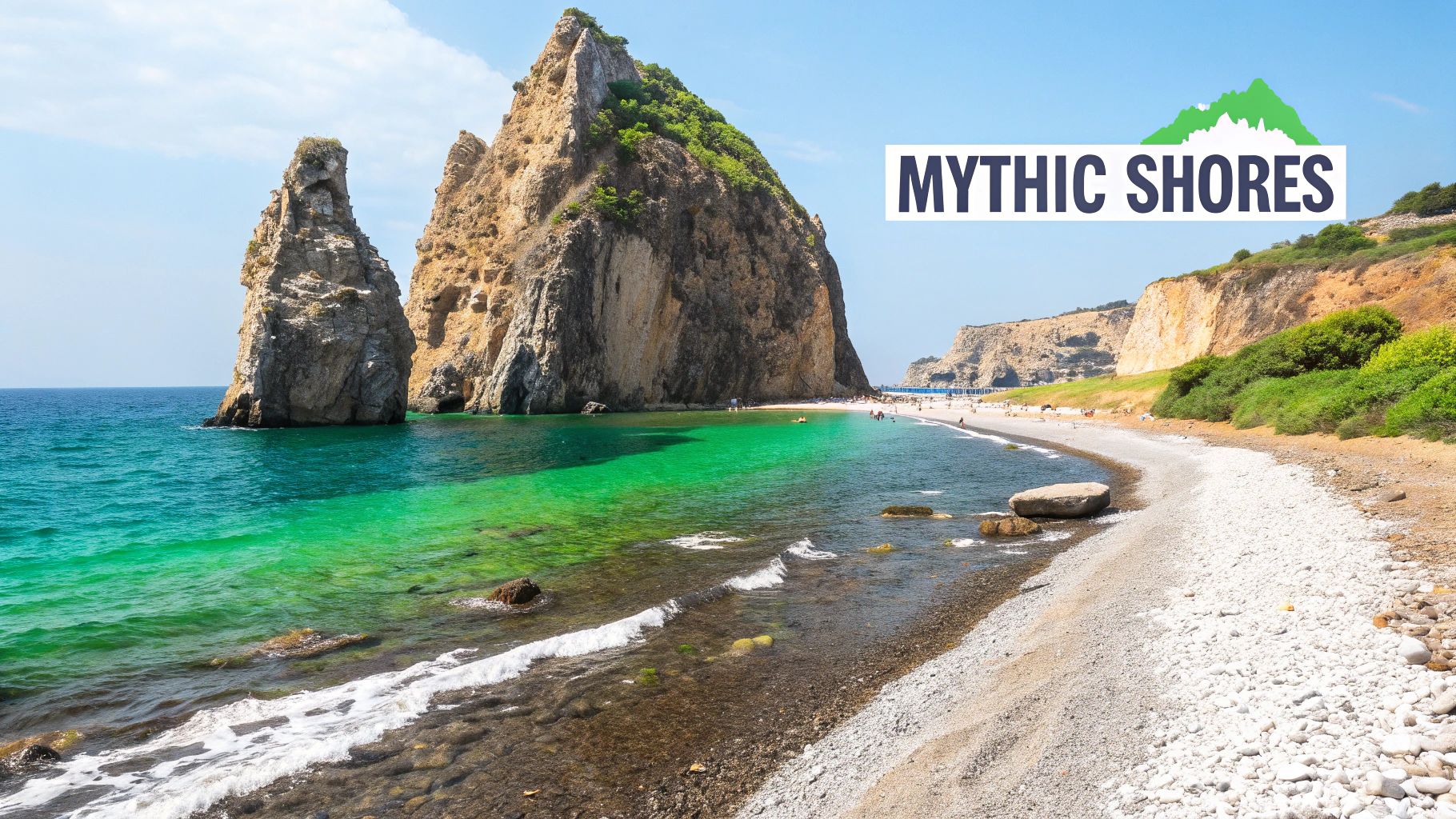
Visitor Information and Practical Tips
For an unforgettable day at this popular spot, consider these practical suggestions:
- Best Time to Visit: To secure a prime sunbed position and enjoy the calm before the crowds, arrive before 9 a.m. For a more relaxed experience with fewer people, plan your visit for the shoulder seasons of May, June, or September.
- What to Bring: Standard beach essentials like sun cream, a hat, and sunglasses are a must. Consider bringing reef shoes if you plan to walk across the sandbar to the rocky islet, as the surface can be uneven.
- Combine Your Trip: If the main beach becomes too busy, the nearby Makronissos Beach offers a quieter but equally beautiful alternative. For a more detailed guide to planning your visit, you can learn more about Nissi Beach and Ayia Napa holidays.
5. Kourion Archaeological Site
Discover one of the most impressive attractions in Cyprus at the Kourion Archaeological Site, a magnificent ancient city-kingdom perched dramatically atop coastal cliffs near Limassol. This sprawling site offers breathtaking views of the Mediterranean Sea and a fascinating journey through Cyprus's history, from the Hellenistic period to Roman and early Christian times. Its centrepiece is the spectacular Greco-Roman theatre, which has been beautifully restored and is still used for open-air performances today.
Beyond the theatre, you can wander through the remains of grand villas adorned with intricate and well-preserved mosaic floors, such as those in the "House of Eustolios" and the "House of Achilles". These mosaics depict vivid scenes from Greek mythology and daily life, showcasing the incredible artistry of the era. The sheer scale of the site, combined with its stunning location, makes it a truly unforgettable experience.
Visitor Information and Practical Tips
To get the most out of your visit to this historical gem, consider these practical tips:
- Best Time to Visit: The site is very exposed, so it's best to visit in the early morning or late afternoon to avoid the intense midday heat, especially in summer. The low-angle light during these times also beautifully illuminates the ruins and mosaics.
- What to Bring: Comfortable footwear is essential for exploring the large and uneven site. Be sure to bring a hat, sunglasses, sun cream, and a generous supply of water. The sea breeze can be deceptive, but the sun is strong.
- Combine Your Trip: Plan for at least two to three hours to explore the main site. For a full day of historical exploration, combine your visit with the nearby Sanctuary of Apollo Hylates (a short drive away) and the medieval Kolossi Castle. Check the local events schedule, as catching a summer play in the ancient theatre is a magical experience.
6. Aphrodite's Rock (Petra tou Romiou)
Experience the mythological heart of Cyprus at Aphrodite's Rock, one of the island's most iconic and photogenic attractions. Legend claims this is the sacred birthplace of Aphrodite, the ancient Greek goddess of love and beauty, who rose from the sea foam at this very spot. The dramatic sea stacks piercing the turquoise waters create a breathtaking coastal scene that has inspired artists and lovers for centuries.
This legendary location, also known as Petra tou Romiou ("Rock of the Greek"), is more than just a beautiful beach; it's a place steeped in myth and romance. While swimming around the rock is said to grant eternal beauty, the real magic lies in its stunning natural setting. It remains a powerful symbol of Cyprus and a must-see for anyone exploring the Paphos district.
Visitor Information and Practical Tips
To fully appreciate this legendary site, consider these practical tips for your visit:
- Best Time to Visit: Arrive at sunrise or sunset for the most spectacular views and magical, soft light. These times also offer a quieter, more intimate experience away from the peak tourist crowds.
- What to Bring: The beach is pebbly, so sturdy water shoes are highly recommended for comfortable walking. While swimming is popular, be aware of strong currents; it is safer to paddle near the shore than to attempt swimming around the rock itself.
- Combine Your Trip: Aphrodite's Rock is conveniently located between Paphos and Limassol. Pair your visit with a trip to the nearby Sanctuary of Aphrodite at Kouklia, a significant ancient pilgrimage site, to deepen your understanding of the goddess's cult. The main road has an upper viewing platform perfect for capturing panoramic photos.
7. Cape Greco National Forest Park
Discover the raw, unspoiled beauty of Cyprus at Cape Greco National Forest Park, a protected coastal reserve at the southeastern tip of the island. This stunning attraction is a haven for nature lovers, offering dramatic limestone cliffs, mesmerising sea caves, and some of the clearest turquoise waters imaginable. It is an essential stop for anyone seeking adventure and breathtaking natural scenery.
The park is famous for its unique geological formations, including the iconic Kamara tou Koraka (a natural rock arch) and the stunning sea caves, which are a popular spot for brave cliff jumpers and explorers. With 16 kilometres of marked nature trails winding through juniper and pine forests, it’s a paradise for hikers, cyclists, and photographers looking to capture the rugged Mediterranean coastline at its finest.
Visitor Information and Practical Tips
To fully enjoy your adventure in this natural wonder, consider these practical tips:
- Best Time to Visit: Start your hike or visit early in the morning, especially during summer, to avoid the intense midday heat. The light during sunrise and sunset is spectacular and ideal for photography.
- What to Bring: There are no shops within the park, so bring plenty of water, sun cream, a hat, and some snacks. Good walking shoes are a must for tackling the rocky trails. An offline map of the trails downloaded to your phone is also highly recommended.
- Combine Your Trip: The park is conveniently located between Ayia Napa and Protaras. After exploring, head to the nearby Konnos Bay, a beautiful sheltered beach with full facilities, for a relaxing swim and refreshment. Renting a boat or kayak is a fantastic way to safely explore the sea caves from the water.
8. Kykkos Monastery
Nestled high in the Troodos Mountains, the Holy Royal and Stavropegic Monastery of Kykkos is arguably the most famous and opulent monastery in Cyprus. Founded around the end of the 11th century, it is dedicated to the Panagia (the Virgin Mary) and houses one of three surviving icons believed to have been painted by the Apostle Luke. This sacred icon, encased in silver gilt, remains a powerful symbol of faith and pilgrimage.
The monastery itself is a breathtaking spectacle of Byzantine art, with glittering mosaics, vibrant frescoes, and gold-plated icons adorning its corridors and church. It has played a significant role in the island's history; Archbishop Makarios III, the first President of Cyprus, served here as a novice. Its rich museum further showcases a priceless collection of manuscripts, antiquities, and religious artefacts, making it a key spiritual and cultural attraction in Cyprus.
Visitor Information and Practical Tips
To fully appreciate your journey to this mountain sanctuary, consider these practical tips:
- Dress Code: Visitors are required to dress modestly. Shoulders and knees must be covered to enter the monastery complex. Shawls and appropriate coverings are available at the entrance for those who need them.
- What to Bring: The mountain air can be cooler than the coast, even in summer, so a light jacket or cardigan is advisable. Comfortable shoes are a must for exploring the expansive grounds and museum.
- Combine Your Trip: Don't miss the Throni tis Panagias viewpoint, located just 2km from the monastery. It offers stunning panoramic views of the surrounding landscape and is the burial site of Archbishop Makarios III. Allow at least 1.5 to 2 hours for a complete visit to the monastery and museum.
9. Limassol Old Town and Marina
Experience the dynamic fusion of history and contemporary luxury in Limassol's vibrant heart. The Old Town is a maze of charming, narrow streets radiating from the medieval Limassol Castle, where Richard the Lionheart is said to have married. This historic centre is now a bustling hub of traditional tavernas, artisan shops, and independent art galleries, offering an authentic taste of Cypriot urban life.
Just a short walk away, the sleek Limassol Marina provides a stunning contrast. This modern development is a playground for the affluent, featuring superyachts, designer boutiques, and sophisticated waterfront restaurants. The seamless blend of the old and new makes this area one of the most compelling attractions in Cyprus, showcasing the island's impressive evolution.
Visitor Information and Practical Tips
To fully appreciate the dual character of this destination, consider these practical suggestions:
- Best Time to Visit: Explore the Old Town and its castle in the morning to avoid the heat. As evening approaches, stroll along the marina promenade to enjoy the sunset views and vibrant nightlife. Time your visit for late August/early September to experience the famous Limassol Wine Festival.
- What to Do: Enjoy a traditional meze at a family-run taverna in the Old Town's backstreets. On Fridays, don't miss the local market for fresh produce and crafts. For a cultural fix, explore the Lanitis Carob Mill complex, which houses a museum and various dining options.
- Combine Your Trip: The area is a perfect starting point for exploring more of Limassol. The Molos promenade and sculpture park is adjacent to the Old Town, offering a scenic coastal walk. The Cyprus Historic & Classic Motor Museum is also just a short drive away for a different kind of historical experience.
10. Akamas Peninsula National Park
Explore Cyprus's last great wilderness at the Akamas Peninsula National Park, an unspoiled expanse of outstanding natural beauty on the island's northwestern tip. This rugged, 230-square-kilometre park is a haven for nature lovers, offering a glimpse into what the entire island looked like before development. It's one of the most vital attractions in Cyprus for escaping the crowds and experiencing raw, natural landscapes.
The peninsula is a mosaic of dramatic gorges like the famous Avakas Gorge, secluded sandy coves, and pristine beaches such as Lara Bay, a critical nesting site for green and loggerhead turtles. The area is crisscrossed by stunning hiking trails, including the Aphrodite Trail, which begins at the mythical Baths of Aphrodite grotto. Its rich biodiversity features hundreds of plant species, many of which are endemic to the island.
Visitor Information and Practical Tips
To safely enjoy this wild landscape, careful planning is essential:
- Getting Around: The park's terrain is rough, with many tracks accessible only by 4×4 vehicles, quad bikes, or organised boat trips. Renting an appropriate vehicle gives you the freedom to explore remote spots like Lara Bay at your own pace.
- What to Bring: There are no shops or facilities within the park. You must bring all necessary supplies, including several litres of water per person, food, sun cream, and a hat. Sturdy hiking boots are non-negotiable for tackling the trails.
- Best Time to Visit: To hike, start at sunrise (6-7 AM) during summer to avoid extreme heat. For wildlife, visit Lara Bay early in the morning during nesting season (May-August) to potentially see conservation work in action without disturbing the turtles. To discover even more about this protected area, you can learn more about the Akamas Peninsula on saycyprus.com.
Top 10 Cyprus Attractions Comparison
| Attraction | Implementation Complexity 🔄 | Resource Requirements ⚡ | Expected Outcomes 📊 | Ideal Use Cases 💡 | Key Advantages ⭐ |
|---|---|---|---|---|---|
| Tombs of the Kings, Paphos | Moderate – requires walking on uneven terrain and some exploration underground | Low – affordable entrance (€2.50), simple facilities | Educational insight into ancient funerary practices with well-preserved architecture | History and archaeology enthusiasts; easy day trip from Paphos | Well-preserved ancient tombs; affordable; uncrowded |
| Kyrenia Castle and Harbour | Moderate – involves border crossing and exploring multiple museum sections | Moderate – entrance fee (15-20 TL), needs passport for access | Rich multi-period historical experience and museum visit | Cultural tourists interested in Byzantine to Venetian history | Unique shipwreck museum; scenic harbour; vibrant dining nearby |
| Troodos Mountains and Villages | Higher – requires car rental and navigation on mountain roads | Moderate to high – transport, possible accommodation, varied costs | Diverse seasonal outdoor activities and cultural heritage exposure | Nature lovers, hikers, winter sports enthusiasts | Year-round destination; cool mountain climate; rich culture |
| Nissi Beach, Ayia Napa | Low – easy beach access, crowds can affect experience | Low to moderate – free entry; sunbeds cost extra | Relaxation, water sports, beach parties, and family-friendly recreation | Beachgoers; party seekers; families | Crystal-clear water; Blue Flag beach; lively atmosphere |
| Kourion Archaeological Site | Moderate – involves walking on uneven, exposed clifftop terrain | Low – moderate entrance fee (€4.50) | Immersive Greco-Roman archaeological exploration with sea views | History buffs; theatre and archaeology lovers | Spectacular clifftop site; active ancient theatre |
| Aphrodite's Rock (Petra tou Romiou) | Low – accessible coastal site with no entry fee | Very low – free access, minimal facilities | Scenic and mythologically significant coastal visit | Casual tourists; photographers; romantics | Iconic natural landmark; free access; mythological importance |
| Cape Greco National Forest Park | Moderate – hiking and swimming require fitness and preparation | Low – free entry but no facilities in park | Natural beauty, hiking, snorkeling, and photo opportunities | Outdoor enthusiasts; nature photographers | Unspoiled nature; multiple activity options; free access |
| Kykkos Monastery | Moderate – accessible by mountain road, some restrictions apply | Low to moderate – free entry; museum €5; strict dress code | Religious and cultural heritage experience with art and architecture | Pilgrims; cultural tourists; history enthusiasts | Rich religious heritage; stunning Byzantine art; free main entry |
| Limassol Old Town and Marina | Low to moderate – walkable urban area with mixed conditions | Low to moderate – castle entry (€4.50), dining and shopping vary | Blend of medieval history with modern lifestyle and nightlife | Urban explorers; foodies; shoppers | Authentic local vibe; historic and modern contrast; lively nightlife |
| Akamas Peninsula National Park | Higher – remote access requiring 4×4 and self-sufficiency | Low to moderate – free access; guided tours extra cost | Wilderness hiking, wildlife observation, and coastal exploration | Adventure tourists; wildlife watchers; serious hikers | Untouched wilderness; rare species; varied hiking trails |
Start Planning Your Cyprus Adventure Today
From the sun-drenched shores of Nissi Beach to the cool, pine-scented air of the Troodos Mountains, our journey through the top attractions in Cyprus reveals an island of breathtaking contrasts and profound historical depth. We've unearthed the subterranean grandeur of the Tombs of the Kings, stood in awe at the dramatic cliff-top theatre of Kourion, and felt the legendary presence of Aphrodite at her mythical birthplace. This curated list is more than just a travel itinerary; it's an invitation to experience the multifaceted soul of Cyprus.
You've seen how Cyprus seamlessly blends millennia of history with vibrant modern life. In Limassol, a medieval castle stands moments away from a sleek, contemporary marina, while in Kyrenia, a formidable fortress guards a harbour filled with charming waterside cafes. This diversity is the island's greatest strength, offering a unique holiday experience that can be tailored to any interest. Whether you are an archaeologist-at-heart, a nature enthusiast, or a seeker of sun and sea, the attractions in Cyprus deliver on every front.
Your Next Steps to an Unforgettable Cypriot Holiday
The key takeaway is that Cyprus is not an island you can see in a day. Its treasures are spread across its stunning coastline and rugged interior, demanding exploration. To make the most of your trip, consider these actionable steps:
- Group Attractions by Region: Plan your days geographically. For instance, combine a visit to the Tombs of the Kings with an exploration of Paphos's wider archaeological park. Similarly, a trip to the Akamas Peninsula can be paired with a visit to Aphrodite's Rock.
- Mix Your Itinerary: Balance historical site visits with days dedicated to nature or relaxation. After a morning exploring the Kourion ruins, spend the afternoon unwinding at a nearby beach. After a hike in Cape Greco, enjoy the lively atmosphere of Ayia Napa.
- Embrace Spontaneity: While planning is essential, leave room for unexpected discoveries. You might stumble upon a village festival in the Troodos, find a secluded cove while driving the coast, or be invited to a local taverna for a meal you'll never forget.
By thoughtfully organising your time, you can craft a journey that is both efficient and deeply rewarding. You will move beyond simply seeing the sights to truly experiencing the island's unique rhythm and culture. Each of these attractions in Cyprus offers a distinct piece of the island's story, and piecing them together creates a rich, personal travel narrative. Your adventure on Aphrodite's island is waiting; all that's left is for you to begin.
Ready to turn your travel dreams into reality? Let SayCyprus be your expert guide. Visit SayCyprus for detailed regional guides, insider tips, and customisable itineraries that cover all the best attractions in Cyprus and beyond.








